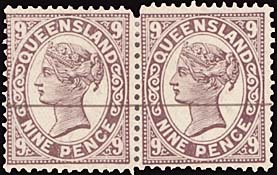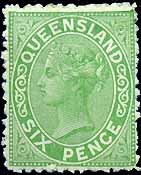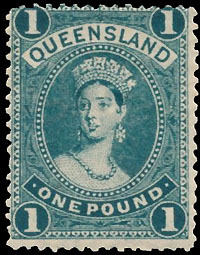The use of stamps for telegrams.
- Australia 1901-1988
- New South Wales
- Overview of NSW
- Telegraph lines
- Telegraph Offices
- Date stamps
- Forms
- Envelopes
- Instructional annotation
- Collect
- Delayed
- Free
- Immediate Urgent
- Reply paid
- Rates
- Stamps
- 1871 Telegraph stamps
- 1885 proposal
- 1893 proposal
- Queensland
- South Australia
- Tasmania
- Victoria
- Western Australia
- International
- Special aspects
The use of stamps to prepay telegraph charges in Colonial Queensland appears to have been authorised in October 1880.
Perhaps one of the first references to the possibility appeared in the 1876 Annual Report to both Houses by Mr. W. J. Cracknell when discussing the shortfall of revenue over income for 1875:
"It is the amendment of the existing routine and scale of charges rather that aught else, which must be looked to in any effort to establish a more even balance (between income and expenditure). To this end, I would suggest that, as in England, messages should be prepaid by stamps, in lieu of cash, and in every respect treated for fiscal purposes like ordinary letters; the originals being sent from the several stations to the central office for audit, and there kept the usual time before being destroyed".
A more practical and relevant approach was outlined in, for example the Western Star and Roma Advertiser of 21 September 1878:
"Telegraphic communication with some of our far out stations continues to be considerably impeded and several suggestions have occurred to us for getting over the difficulties.
It is well known that, at present, persons living beyond reach of the telegraph whenever they desire to forward messages by wire, have to send them by post to the nearest telegraph station - in itself a process entailing much delay and if they wish to ensure transmission they must enclose a money payment. Stamps, for some reason or other, not being accepted. To say the least of it, this is highly inconvenient and might very easily be remedied if a system of issuing telegraph stamps were adopted and the forms used bound in the form of cheque books, stamped and issued to those who require them.
Mr. Palmer and Mr. Morehead suggested some such arrangement towards the close of the last session of Parliament, and if the Government desire to make telegraphy a source of remuneration, we should strongly advise them to take the matter seriously into their consideration.
In October 1880, the Post & Telegraph Act passed by the Queensland Government allowed the payment of telegram charges by use of a postal note or by postage stamps.
The transmission form issued in 1880 was a 1/- postal note (QC-TO-5) with a transmission form on the reverse. The form issued in 1882 (QC-TO-4) had a printed image of a 1/- telegraph stamp which prepaid the cost of a local telegram.
The Brisbane Courier of 5 June 1902 reported the Commonwealth Gazette's announcement of New Postal Regulations - Alterations affecting Queensland:
"... it seems that the principal alterations affecting Queensland will be that, in despatching telegrams within the Commonwealth, there will have to be pre-payment by means of postage stamps. In other words, instead of paying the cost of telegram, the value will have to be purchased and affixed to the telegram form. This system is in force in New South Wales and Victoria".
It may be therefore that the Queensland Colonial regulations required prepayment but that, apart from the two transmission forms noted above, stamps did not have to be attached to a form. Discussions in the Legislative Assembly in November 1888 discussed the prepayment of telegrams. The Member for Ipswich noted
"that hon. Members were aware that, in Melbourne, telegrams could be pre-paid by stamps and that he was going to suggest that the stamps might be cancelled in the office and that would prevent any possibility of fraud.
Mr. Barlow said he would suggest that the system of prepayment for telegrams by stamps would be a great convenience ... if an office were to be closed. By that system, which he believed prevailed in Victoria, postage-stamps could be put in an envelope marked "telegram" and then posted in a pillar-box and forwarded to the head office from whence the telegram would be transmitted. If the office at North Ipswich was to be closed, he thought they should have to ask the hon. gentleman to favour that locality with a few pillar-boxes. The Postmaster-General said the suggestion of the hon. gentleman with regard to sending telegrams by post was a very good one and he would take it into consideration. He knew the system was in force down South, and he did not see why it should not be adopted here".
| Indeed Queensland did not issue transmission forms which had a space for stamps to be affixed until the Interim form in 1904 (QI-TO-1). The use of postage stamps to pay telegram costs was however permitted from 1880. There would have at least been discussion between the Cracknell brothers.
In a parallel initiative, a design was prepared for a stamp with which to pay the 9d intra-state rate for up to 16 words introduced in 1902. The design was rejected by the Postmaster-General who favoured the movement towards a uniform stamp throughout the newly formed States of Australia - and hence supported the design of the 9d Commonwealth stamp. |
 |
9d yellow-orange colour trial prepared to facilitate payment for the 1902 9d intra-state telegram rate.
Printed on Crown over Q paper and defaced with a ruled black ink line. Prestige Philately May 2007 Lot 302. |
 |
9d slate-purple colour trial prepared to facilitate payment for the 1902 9d intra-state telegram rate.
Printed on Crown over Q paper and defaced with a ruled black ink line. Prestige Philately September 2007 Lot 357. |
|
 Provenance: Dave Elsmore. |
9d green colour trial prepared to facilitate payment for the 1902 9d intra-state telegram rate.
Printed on Crown over Q paper and defaced with a ruled red ink line. There is damage to the engraving at the base of the neck and to the adjoining frame. |
The Government Gazette announced that, "from 1 January 1880, the present postage stamps from one penny to one shilling, and the present duty stamps from two shillings upwards, will in future be the only stamps issued; and each denomination will be available to the full extent of its nominal value for all purposes for which separate stamps have hitherto been required".
Low denominations of 6d, 9d, 1/- and 2/- were printed in two different side-face designs during the period from 1885 to about 1907.
6d side face design. Printed without 6d denomination in corners to 1890. Then with 6d denomination in all corners and with different watermarks and perforations. |
 6d green. Perf: 12 1882-90. |
 6d green. Crown over Q watermark Perf: 13 × 11. 1897-1907. |
1/- side face design. Printed without 1/- denomination in corners to 1890. After 1897 with 1/- denomination in all corners and with different watermarks and perforations. |
 1/- bright mauve. Perf: 12½. 1897-1907 with Crown over Q watermark and from 1908 with Crown over double lined A watermark. |
2/- side face design.
|
2/-brown CK |
 2/- Queen Victoria sideface turquoise-green pair. (1897-1907). Has an ELECTRIC TELEGRAPH double oval hand stamp of Townsville (no date inside). Ebay (Status Auctions) 2012. |
|
| In 1903, Queensland - in association with New South Wales - issued a special design for a possible Commonwealth issue. Its denomination was 9d - and it was therefore possible to use it to pay intra-state telegram charges. It was the only 9d stamp issued by Queensland - the 9d design shown above being rejected.
Two slightly different designs were produced:
|
 Pair of the Queensland Commonwealth issue. Type A (left) and Type B (right). |
In 1882, four high value denominations with the Chalon design were issued. The same designs were issued again in 1886, 1895 and 1905-1907 printed on different watermarked papers and these last two printings would have been used to pay telegram costs. Examples of these stamps are shown below:
 |
 |
 |
 |
2/6 vermillion. 1882 - 1907 (various watermarks). Phoenix sale 14 lot 1138. |
5/- rose. 1882 - 1907 (various watermarks). |
10/- brown. 1882 - 1907 (various watermarks). |
£1 blue-green. 1882 - 1907 (various watermarks). Prestige Philately sale 175 lot 372. |